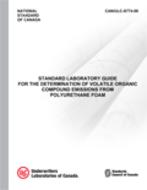
ULC 774
- Comments Off on ULC 774
- CAN-ULC
Click here to purchase
“This laboratory guide has been developed for the assessment of volatile organic compound (VOC) emissions from materials used in residential buildings. The guide specifies recommended procedures for the use of test chambers to evaluate emissions from the material at a point in time following its installation. The guide includes: A head-space analysis procedure for initial identification of VOCs released by the material; Two dynamic chamber procedures for characterizing the rate of VOC emissions from the material; A methodology for calculating the estimated indoor air concentrations of VOCs based on the results of dynamic chamber testing.The head-space analysis is a static test to identify significant amounts of emitted compounds from the material. It is followed by one of the dynamic chamber procedures.The first procedure measures the typical VOC emission characteristics of the material. The test is conducted after conditioning the specimen for 30 days. The second procedure measures the typical VOC emission profile of the material commencing 24 hours after installation and continuing for 30 days thereafter. The results of are used to calculate indoor air VOC concentration profiles and to determine the acceptability of the material for new construction and/or retrofit use.The first procedure is used to evaluate the material in new residential construction when there is a minimum of 30 days from the installation to building occupancy.The second procedure is a more complex evaluation of the material when the normal 30 days minimum airing out time associated with new construction is not provided (e.g. occupied buildings).In these special cases (e.g. occupied buildings), the application and installation standard will provide the requirements for isolation and ventilation, if necessary. The test results of the second procedure will determine the length of time that these requirements are necessary. The methodology for assessing the acceptability of the material utilizes comparison of the estimated indoor air concentration of VOCs with permissible concentration.”
Product Details
- Edition:
- 2
- Published:
- 01/01/2014

